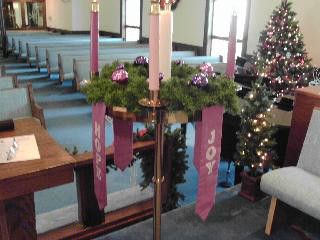Gaudete Sunday
This article needs additional citations for verification. (August 2013) |

Gaudete Sunday /ɡaʊˈdeɪteɪ/ is the third Sunday of Advent in the liturgical calendar of the Western Church, including the Roman Catholic Church, the Anglican Communion, many Lutheran Churches, and other mainline Protestant churches. It can fall on any date from 11 December to 17 December.
"Gaudete"
The day takes its common name from the Latin word Gaudete ("Rejoice"), the first word of the introit of this day's Mass:[1]
Gaudete in Domino semper: iterum dico, gaudete. Modestia vestra nota sit omnibus hominibus: Dominus enim prope est. Nihil solliciti sitis: sed in omni oratione petitiones vestræ innotescant apud Deum. Benedixisti Domine terram tuam: avertisti captivitatem Jacob.
This may be translated as
Rejoice in the Lord always; again I say, rejoice. Let your forbearance be known to all, for the Lord is near at hand; have no anxiety about anything, but in all things, by prayer and supplication, with thanksgiving, let your requests be known to God. Lord, you have blessed your land; you have turned away the captivity of Jacob.
— Philippians 4:4–6; Psalm 85 (84):1

Background
The season of Advent originated as a fast of forty days in preparation for Christmas, commencing on the day after the feast of St. Martin (12 November), whence it was often called "St. Martin's Lent"—a name by which it was known as early as the fifth century. In the ninth century, the duration of Advent was reduced to four weeks, and Advent preserved most of the characteristics of a penitential season which made it a kind of counterpart to Lent. Gaudete Sunday is a counterpart to Laetare Sunday, and provides a similar break about midway through a season which is otherwise of a penitential character, and signifies the nearness of the Lord's coming.[1]
The spirit of the Liturgy all through Advent is one of expectation and preparation for the feast of Christmas as well as for the second coming of Christ, and the penitential exercises suitable to that spirit are thus on Gaudete Sunday suspended, as were, for a while in order to symbolize that joy and gladness in the promised Redemption.[1]
Liturgical color
On Gaudete Sunday rose-colored vestments may be worn instead of violet, (or in the Anglican tradition and some Lutheran traditions, Sarum blue) which is otherwise prescribed for every day in the season of Advent. This tradition, previously informally observed in the Anglican Church, was formally noted as an option in the Church of England in the Common Worship liturgical renewal.[2] In churches that have an Advent wreath, the rose colored candle is lit in addition to two of the violet (or blue) colored candles, which represent the first two Sundays of Advent. Despite the otherwise somber readings of the season of Advent, which has as a secondary theme the need for penitence, the readings on the third Sunday emphasize the joyous anticipation of the Lord's coming.
Gallery
-
An Advent Wreath with the customary single candle in rose for Gaudete Sunday
-
Roman Catholic Mass celebrated on Gaudete Sunday by the Congregation of the Sons of the Most holy Redeemer. The priest is wearing the customary rose vestments.
See also
- Laetare Sunday
- Advent Sunday
- Gaudete, a Christmas carol
References
- ^ a b c Alston, George Cyprian. "Gaudete Sunday." The Catholic Encyclopedia. Vol. 6. New York: Robert Appleton Company, 1909. 13 Oct. 2013
- ^ The traditional use of rose-pink vestments on this day is suggested in the liturgical color sequence notes of Common Worship of which an on-line version may be found here.


